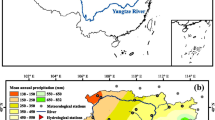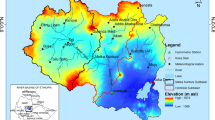Abstract
The runoff and sediment load of the Loess Plateau have changed significantly due to the implementation of soil and water conservation measures since the 1970s. However, the effects of soil and water conservation measures on hydrological extremes have rarely been considered. In this study, we investigated the variations in hydrological extremes and flood processes during different periods in the Yanhe River Basin (a tributary of the Loess Plateau) based on the daily mean runoff and 117 flood event data from 1956 to 2013. The study periods were divided into reference period (1956–1969), engineering measures period (1970–1995), and biological control measures period (1996–2013) according to the change points of the annual streamflow and the actual human activity in the basin. The results of the hydrological high extremes (HF1max, HF3max, HF7max) exhibit a decreasing trend (P < 0.01), whereas the hydrological low extremes (HBF1min, HBF3min, HBF7min) show an increasing trend during 1956–2013. Compared with the hydrological extremes during the reference period, the hydrological high extremes increased during the engineering measures period at low (< 15%) and high frequency (> 80%), whereas decreased during the biological control measures period at almost all frequencies. The hydrological low extremes generally increased during both the engineering measures and biological control measures periods, particularly during the latter period. At the flood event scale, most flood event indices in connection with the runoff and sediment during the engineering measures period were significantly higher than those during the biological control measures period. The above results indicate that the ability to withstand hydrological extremes for the biological control measures was greater than that for the engineering measures in the studied basin. This work reveals the effects of different soil and water conservation measures on hydrological extremes in a typical basin of the Loess Plateau and hence can provide a useful reference for regional soil erosion control and disaster prevention policy-making.












Similar content being viewed by others
References
Angulo-Martínez M, Beguería S (2009) Estimating rainfall erosivity from daily precipitation records: a comparison among methods using data from the ebro basin (ne spain). J Hydrol 379(1):111–121
Arnold JG, Allen PM (1999) Automated Methods for Estimating Baseflow and Ground Water Recharge From Streamflow Records. J Am Water Resour Assoc 35(2):411–424
Bao Z, Zhang J, Wang G, Chen Q, Wang J (2019) The impact of climate variability and land use/cover change on the water balance in the middle yellow river basin, china. J Hydrol 577:123942
Brown AE, Western AW, McMahon TA, Zhang L (2013) Impact of forest cover changes on annual streamflow and flow duration curves. J Hydrol 483:39–50
Burn DH, Elnur MA (2002) Detection of hydrologic trends and variability. J Hydrol 255(1):107–122
HSBC, (2011) Climate investment update. HSBC Global Research. www.research.hsbc.com. Accessed 13 Oct
Easterling DR (2000) Climate extremes: observations, modeling, and impacts. Science 289(5487):2068–2074
Eckhardt K (2005) How to construct recursive digital filters for baseflow separation. Hydrol Proc 19(2):507
Fan RS, Yan FC (1989) Rainstorm flood in July 1977. J China Hydrol 1:52–57 (In Chinese)
Fang HY, Cai QG, Chen H, Li QY (2008) Temporal changes in suspended sediment transport in a gullied loess basin: the lower Chabagou Creek on the Loess Plateau in China. Earth Surf Proc Landform 33:1977–1992
Gao P, Jiang G, Wei Y, Mu X, Wang F, Zhao G, Sun W (2015) Streamflow regimes of the Yanhe River under climate and land use change, Loess Plateau China. Hydrol Process 29(10):2402–2413
Gao P, Deng J, Chai X, Mu X, Zhao G, Shao H (2017) Dynamic sediment discharge in the hekou-longmen region of yellow river and soil and water conservation implications. Sci Total Environ 578(1):56–66
Gu CJ, Mu XM, Sun WY, Gao P, Zhao GJ (2017) Comparative analysis of the responses of rainstorm flood and sediment yield to vegetation rehabilitation in the Yanhe River Basin. J Nat Resour 32(10):1755–1767 (In Chinese)
Gu C, Mu X, Gao P, Zhao G, Sun W (2019a) Changes in run-off and sediment load in the three parts of the Yellow River basin, in response to climate change and human activities. Hydrol Process 33(4):585–601
Gu CJ, Mu XM, Gao P, Zhao GJ, Sun WY, John T (2019b) Influence of vegetation restoration on soil physical properties in the loess plateau, china. J Soils Sediments 19:716–728
Herschy RW (2002) The world`s maximum observed floods. Flow Measure Instrument. https://doi.org/10.1016/S0955-5986(02)00054-7
Hu J, Zhao G, Mu X, Tian P, Gao P, Sun W (2019) Quantifying the impacts of human activities on runoff and sediment load changes in a loess plateau catchment, china. J Soils Sediments 19(11):3866–3880
Huang YH, Feng W, Li ZG (2014) Characteristics and geological disaster mode of the rainstorm happened on July 3. 2013 in Yanan Area of Shaanxi Province. J Catastrophol 29(2):54–59
Kang SZ, Zhang L, Song XY, Zhang SH, Liu XZ, Liang YL, Zheng SQ (2001) Rainfall and land runoff and sediment loss responses use in two agriculture catchments on the Loess Plateau of China. Hydrol Process 15:977–988
Kendall MG (1975) Rank correlation methods. Griffin, London, UK
Lei YN, Zhang XP, Zhang JJ, Liu EJ, Zhang QY, Chen N (2011) Suitability analysis of automatic baseflow separation methods in typical watersheds of water-wind erosion crisscross region on the Loess Plateau, China. Sci Soil Water Conserv 9(6):57–64 (in Chinese)
Li X, Zhang Q, Xu CY, Ye X (2015) The changing patterns of floods in poyang lake, china: characteristics and explanations. Nat Hazards 76:651–666
Liang W, Bai D, Wang F, Fu B, Yan J, Wang S (2015) Quantifying the impacts of climate change and ecological restoration on streamflow changes based on a budyko hydrological model in china’s loess plateau. Water Resour Res 51(8):6500
Liu XY, Ma SY, Dang SZ (2017) Processes of sediment yield in the Yellow River basin in recent hundred years. J Sed Res 42(05):1–6
Mann HB (1945) Non-Parametric Test against Trend. Econometrika 13:245–259
Martinez JM, Toan T (2007) Mapping of flood dynamics and spatial distribution of vegetation in the Amazon floodplain using multitemporal SAR data. Remote Sens Environ 108(3):209–222
Menzel L, Bürger G (2002) Climate change scenarios and runoff response in the mulde catchment (southern elbe, germany). J Hydrol 267(1):53–64
Milly PCD, Wetherald RT, Dunne KA, Delworth TL (2002) Increasing risk of great floods in a changing climate. Nature 415(6871):514–517
Milly PCD, Dunne KA, Vecchia AV (2005) Global pattern of trends in streamflow and water availability in a changing climate. Nature 438:347–350
Moraes JM, Pellegrino GQ, Ballester MV, Martinelli LA, Victoria RL, Krusche AV (1998) Trends in hydrological parameters of a southern Brazilian watershed and its relation to human induced changes. Water Res Manag 12(4):295–311
Nathan R, Mcmahon TA (1990) Evaluation of automated techniques for base flow and recession analyses. Water Resour Res 26(7):1465–1473
Nie CJ, Li HR, Yang LS, Wu SH, Liu Y, Liao YF (2012) Spatial and temporal changes in flooding and the affecting factors in China. Nat Hazards 61:425–439
Piao S, Ciais P, Huang Y, Shen Z, Peng S, Li J, Fang J (2010) The impacts of climate change on water resources and agriculture in China. Nature 467(7311):43–51
Sen Z (1998) Average areal precipitation by percentage weighted polygon method. J Hydrol Eng 3(1):69–72
Sun W, Mu X, Song X, Wu D, Cheng A, Qiu B (2016) Changes in extreme temperature and precipitation events in the loess plateau (china) during 1960–2013 under global warming. Atmos Res 168(1):33–48
UNDP (2004) A global report: reducing disaster risk-a challenge for development. John S. Swift Co., New York
Villarini G, Smith JA, Serinaldi F, Ntelekos AA, Schwarz U (2012) Analyses of extreme flooding in austria over the period 1951–2006. Int J Climatol 32(8):1178–1192
Wan S, Zhang J, Wang G, Zhang L, Lei C, Amgad E et al (2020) Evaluation of changes in streamflow and the underlying causes: a perspective of an upstream catchment in haihe river basin, china. J Water Clim Change 11(1):241–257
Wang Y, Ding Y, Ye B, Liu F, Wang J (2013) Contributions of climate and human activities to changes in runoff of the Yellow and Yangtze rivers from 1950 to 2008. Sci China-Earth Sci 56(8):1398–1412
Wang F, Hessel R, Mu X, Maroulis J, Zhao G, Geissen V et al (2015) Distinguishing the impacts of human activities and climate variability on runoff and sediment load change based on paired periods with similar weather conditions: a case in the yan river, china. J Hydrol 527:884–893
Wang S, Fu B, Piao S, Lu Y, Ciais P, Feng X, Wang Y (2016a) Reduced sediment transport in the Yellow River due to anthropogenic changes. Nat Geosci 9(1):38–41
Wang G, Zhang J, Yang Q (2016b) Attribution of runoff change for the xinshui river catchment on the loess plateau of china in a changing environment. Water 8(6):267
Wu ZY, Lu GH, Liu ZY, Wang JX, Xiao H (2013) Trends of extreme flood events in the pearl river basin during 1951–2010. Adv Clim Change Res 4(2):110–116
Xu Z, Bennett MT, Tao R, Xu J (2004) China’s sloping land conversion programme four years on: current situation, pending issues. Int for Rev 6(3):317–326
Yang Q, Zhang H, Peng W, Lan Y, Luo S, Shao J et al (2019) Assessing climate impact on forest cover in areas undergoing substantial land cover change using landsat imagery. Sci Total Environ 659:732–745
Yuan XP, Lei TW (2004) Soil and water conservation measures and the benefits in runoff and sediment reductions. Trans CSAE 20(2):296–300 (in Chinese)
Zhang Q, Sun P, Chen X, Jiang T (2011) Hydrological extremes in the Poyang Lake basin, China: changing properties, causes and impacts. Hydrol Process 25(20):3121–3130
Zhao G, Tian P, Mu X, Jiao J, Wang F, Gao P (2014b) Quantifying the impact of climate variability and human activities on streamflow in the middle reaches of the yellow river basin, china. J Hydrol 519:387–398
Zhao YZ, Mu XM, Yan BW, Zhao GJ (2014a) Influence of vegetation restoration on runoff and sediment of Yanhe basin. J Sed Res 000(004):67–73 (In Chinese)
Zhiyong W, Guihua L, Zhiyu L, Jinxing W (2012) Trends of extreme flood events in the pearl river basin under climate change. Progressus Inquisitiones De Mutatione Climatis 8(6):403–408
Zhou JQ (2015) Reflection and countermeasure to rainstorm happened on July 3. 2013 in Yanan Area of Shaanxi Province. China Flood Drought Manag 3:93–94 (In Chinese)
Acknowledgements
This work was supported by National Natural Science Foundation of China (4207072131) and (41671285), the National Key Research and Development Program of China (2016YFC0501707, 2016YFC0402401).
Author information
Authors and Affiliations
Contributions
Chaojun Gu carried out data processing, data analysis and wrote the paper. Yongqing Zhu designed the research framework. Renhua Li, He Yao, and Xingmin Mu offered guidance to complete the work and made revisions to the manuscript.
Corresponding author
Ethics declarations
Conflict of interest
The authors declare that there is no conflict of interest.
Additional information
Publisher's Note
Springer Nature remains neutral with regard to jurisdictional claims in published maps and institutional affiliations.
Rights and permissions
About this article
Cite this article
Gu, C., Zhu, Y., Li, R. et al. Effects of different soil and water conservation measures on hydrological extremes and flood processes in the Yanhe River, Loess Plateau, China. Nat Hazards 109, 545–566 (2021). https://doi.org/10.1007/s11069-021-04848-w
Received:
Accepted:
Published:
Issue Date:
DOI: https://doi.org/10.1007/s11069-021-04848-w




